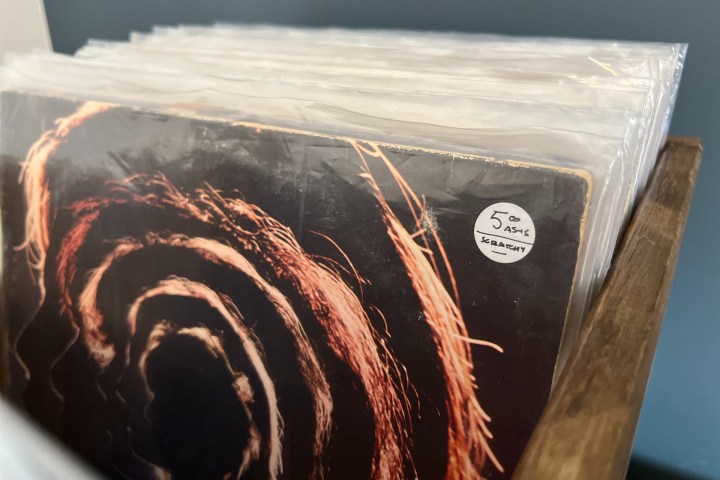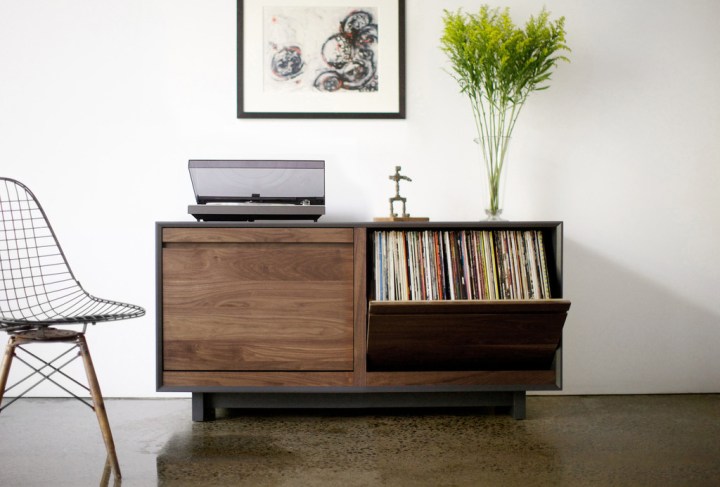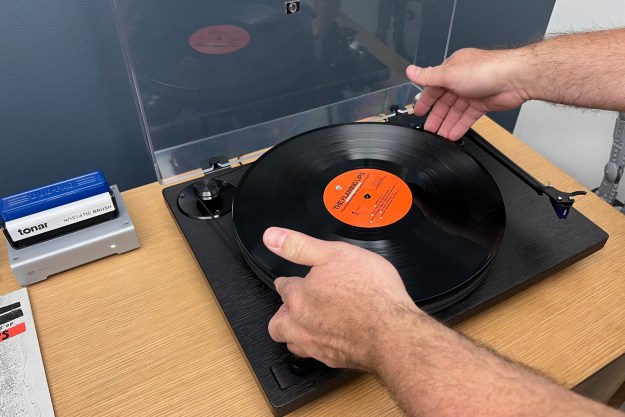Your Miles Davis-loving father-in-law has been harping on about the superior warmth and soundstage of his pristine vinyl collection since you married his daughter, but it’s time to face the facts: Sometimes old people are right. The resurgence of vinyl’s popularity over the last 14 or so years is no joke. With sales of the waxy medium in 2021 reaching their highest level in 30 years (by mid-2021, U.S. vinyl sales topped $467-million, up 94% from 2020), even with pandemic-driven record store closures, vinyl is the preferred physical form of music in the U.S. and worldwide, easily outselling CDs.
And while it may not be as convenient as firing up Apple Music on your smartphone or asking Alexa to play Machine Gun Kelly on repeat, there’s a tangible aesthetic beauty to listening to a vinyl record while getting lost in its cover art that digital streaming services can’t compete with, and everyday music lovers and analog geeks alike have been flocking to it.
If you’ve been drawn to the world of vinyl records yourself and don’t know where to start, don’t worry — building and properly maintaining a record collection isn’t complicated, and it doesn’t have to be expensive either. But there are some things to keep in mind if you’re considering the analog audio lifestyle.
Here is our top-to-bottom (er, side A-to-B?) guide covering everything from how to buy and hook up a quality turntable to proper vinyl cleaning and storage, right down to some minor tweaks you can make to your gear to improve its sound.

Buy some records
Record collecting has looked a little different over the past couple of years, largely due to the pandemic forcing many record stores to either close, go out of business altogether, or greatly adapt their operations to more online-focused models.
If you do have the opportunity to go for a dig at your local record store, there’s no better way to explore the world of vinyl. Not only is it a way to embrace your newfound community and support local businesses, but you’ll not find a better source of information and inspiration than from the vinyl heads at record stores. You’ll find that they’re always up for geeking out about the latest reissue, the selection of classics in their used record bins, or the rare pressings you’ve been looking for. Don’t be afraid to tell them what you’re into or ask them what else they think you might like. You might just find a new favorite band or record.

Buying used
As for used records, there is an art to selecting good ones. We don’t mean by title; instead, by the quality and condition of the vinyl itself. There is a universally-accepted vinyl grading system you’ll often find referenced in record stores, with those selling vinyl privately, and with larger online resources such as Discogs.com, which is the most well-known online record-selling, -cataloging, and -trading platform out there. That grading label system is as follows:
Poor (P) or Fair (F): Pretty self-explanatory — this is a record in bad condition and usually has scratches, skips, warps in the vinyl that are often audible, noise, and other imperfections. Unless it’s in a dollar bin, take a pass on this vinyl.
Good (G) or Good+ (G+): Not quite as straightforward as it sounds, a G grading doesn’t always mean good. Discogs describe this rating as a record that can be played without skipping but could have scratches, surface noise, or visible groove wear. The sleeve is likely split, cracked, or held together with tape.
Very Good (VG): It’s common for VG-graded records to have some surface noise, groove wear, and light scratches that will be audible when played, but usually only during softer parts.
Very Good+ (VG+): Usually taken good care of by their previous owners, a VG+ record could have some light wear and surface defects that are usually inaudible. Unless it’s a rare record at a good price that you must have, VG+ should be the baseline that you strive for with used records.
Near Mint (NM or M-): This is basically any record other than a new one that has likely never been played or only been played a handful of times and will play perfectly. It should have no signs of wear, and its packaging should be untouched.
Mint (M): These are perfect vinyls, having either never been played or potentially even still factory sealed. Used record retailers rarely label their records with the Mint grading.
That said, when checking out the condition of a used record, don’t just take the grading label at face value — you don’t know how good that High Fidelity Jack Black wannabe’s read on record quality is; look for yourself by taking the record out and visually inspecting it.
Look past the dust for deep scratches or particularly long ones you can feel with your finger as you run it across the grooves. If you’re just not sure, most record stores will have a listening station set up, so use it and decide for yourself if it’s up to par. If not, try another copy, or look for that title elsewhere. If the record just looks dirty, you can ask the store to clean it for you. If they have a cleaning machine, they’ll often do it free of charge.
Speaking of looking for different copies of your favorite records, be on the lookout for bootleg versions of records. They’re usually the really cheap ones, and they can be awesome — or they can be terrible. You can sometimes tell by their lighter-than-normal weight, but you can also always ask at the counter. Typically, this simple rule will help you sniff out bootleg vinyl: If it seems too good to be true when it comes to a golden find, it’s probably not an original pressing.
If it’s a quality bootleg (we own plenty), it can be a real steal, but you should always try to give it a listen for yourself if there is a listening station available.
New vinyl and online shopping
With the growth of the vinyl market, most record labels big and small offer their artist’s work in vinyl and have been busy repressing their back catalogs. There’s a seemingly never-ending selection of newly-minted box sets, anniversary special editions with never-released music, and all manner of colored versions with splatters and textures to choose from to draw you in. It truly is a music lover’s paradise, if you’re into that sort of thing.
These days, you don’t have to go anywhere to find your favorite band’s vinyl. Though we still recommend checking out vinyl in person before purchasing, there are solid online resources. For new vinyl, we first recommend checking out the online ordering options for your local record stores. They often have great selections of new and used vinyl, and you can even give them a call before you buy if you have questions about a certain record.
Otherwise, Amazon has a surprisingly good selection at standard prices, often with free shipping. For used records online, check out the aforementioned Discogs. A fantastic resource for researching records in general — it’s a deep rabbit hole, believe us — Discogs can help you find some of the rarest “holy grail” gems on your list, with marketplace options that span sellers across the globe. Want that rare Best Of Radiohead box set and are willing to pay the shipping costs to get it to you from Japan? Discogs is your best bet.
Oh, and if you need a little help discovering record stores in your area that will be celebrating Record Store Day, we also recommend Vinyl Hub — “it’s like Discogs for record stores” the website exclaims, and it offers a great way to find a local shop.
Clean those grooves!
So you’ve just gotten your vinyl haul home, and you’re ready to light up your favorite speakers with the sweet analog sounds of that Beatles Let it Be pressing you’ve been seeking out for months. We’re excited too, but don’t just slip that slick disc out of its cover and drop the needle right away. Before you play them, you should always clean your records.
You have no idea how well any used record was kept over its lifetime, and even brand new records have a residue left over from the pressing factory. You want none of this stuff touching your turntable’s stylus (needle). There are a number of ways to clean a record, some of them totally automated and using sophisticated ultrasonic devices such as the expensive Okki Nokki, others very hands-on like the manual and readily-available Spin Clean. To help you out, we put together this excellent guide on how to clean your records.

All the ways to play
Now that your collection is clean, they’re ready to play. If you already have a record-playing rig you love, then congratulations! But if you’re starting from scratch or looking to upgrade, you have some decisions to make.
There are several different types of turntables out there, and many of them are now conveniently available in what used to be very unlikely places. The resurgence of vinyl is seeing turntables being sold at mega-stores like Target and Walmart. But don't do that. If you want to experience all the warmth and detail vinyl has to offer, and make sure your records are treated right, you’ll want to make a small investment into something with a bit better quality — you'll thanks us later.
Stay away from all-in-ones
While you will find some decent affordable turntables at budget stores, we highly recommend staying away from the many all-in-one style turntables with built-in amplification and speakers. These will get you playing immediately with minimal effort. However, you’re limited by the weak amp and small speakers found in these products, and none of the parts, like tonearms, cartridges, or styluses, are upgradeable. The portable convenience may be good in a pinch, but not a treat for your ears.
Turntable it up
For just a little bit more cash, you can get yourself a significantly superior turntable with quality, upgradeable parts that will last you for years to come — or at least until your obsession grows and you start mortgaging your house to fund it. We’re kidding (sort of), but let’s stick to keeping your wallet safe as you get started with this list of our favorite affordable turntables. Some of them are in the $200 to $500 range and outfitted with solid cartridges (the main device at the end of the tonearm that houses the needle and delivers the sound from the record to your chosen sound system) right out of the box. A good cartridge can make or break a turntable, and upgrading to a step-up brand such as Ortofon, Shure, Clearaudio, or Rega can change the whole sound of your set-up.
Receivers, speakers, and pre-amps
There are several ways to get the sweet vinyl sounds off your records and into your ears, and they each rely on your needs, budget, and how discerning you are with the audio you want to hear. Chances are, if you’re reading this, you’re just starting your vinyl journey, so a $30,000 audiophile system isn’t likely in your purview (yet).
For most newbs, a decent turntable with a built-in phono pre-amp and a pair of sweet powered speakers is all you need to fill a room with music. If you’re a Sonos person and also love your digital streaming setup, with the addition of a relatively inexpensive external phono pre-amp and the proper cables, you can use the Sonos Play 5’s line input to add a turntable to the mix for a whole new avenue of music.
If you already have an integrated amp or A/V receiver, see if it has a phono input. Newer stereo receivers typically have them built in, but if not, using an above-mentioned phono pre-amp to boost the turntable’s signal — unless the turntable also has a pre-amp built-in — can even improve your sound quality over a built-in phono port. Some turntables, like the Audio-Technica AT-LP120, also include USB outputs for archiving vinyl into digital audio files.
As we said, there are loads of ways to listen to your new record collection. We recommend starting somewhere based on your budget while looking for components that allow you to upgrade later, because, believe us, once you get the vinyl bug it’s just upwards from there.

Keep your gear clean
We talked above about cleaning your used records before giving them a spin, but arguably more important is the regular cleaning habits you should adopt to keep your records and your turntable’s ever-important stylus in tip-top shape. This will help them to both perform better and last longer.
Carbon fiber, anti-static brush
One of the most essential pieces of gear for any record collector, running an anti-static brush around your records before and after each spin will help reduce dust buildup on your stylus and in the grooves of your records that can damage both over time. You can find them at any record store and they’re readily available on Amazon for under $20.
Gel pad stylus cleaner
Ideal and accurate sound reproduction depends on there being good contact between the stylus tip and the grooves of the record. Dust and dirt accumulation on your stylus gets in the way of this contact. We recommend keeping your stylus clean with either a traditional stylus brush or, as we’ve found to work best, a gel pad-style cleaner like this ZeroDust cleaner from Oznow. Just lower your stylus onto the sticky gel pad that will gently pull any dust and debris from it and the surrounding cartridge surface.

Store it!
How you store your records isn’t just important for preservation, it’s an opportunity to build something that looks really, really cool.
But first, we just have to say: Do not use milk crates. Long have they been used by DJ’s to cart their wax back and forth from clubs, but rest assured they’re a sub-par record storage method for a number of reasons, including sharp edges that like to tear up sleeves and the tendency to flex under a heavy load, potentially warping records. That, and if you’re keeping your records in a visible area in your home, like a living room or media room, they just look bad.
For home storage, any number of shelving options will work, but one of the most popular options comes from our Swedish friends at Ikea: The Kallax Shelving Unit. While the Kallax isn’t as robustly built as its Expedit ancestor (no longer available), this solution should last for many years with care. Plus, they’re the perfect size and modular, so you can put one in a little nook or build an entire wall full of wax.
For portable vinyl storage, there’s a big selection of compact wooden crates designed specifically for carrying vinyl anywhere. Some even double as stackable storage at home until you graduate to a larger furniture solution like mentioned above.
Also, don’t forget that anti-static inner sleeves are imperative for keeping your records from building up damaging static electricity. These sleeves from Mobile Fidelity are outstanding. You might even consider plastic outer sleeves (you can usually get these free with purchase at most record stores) to keep dust off your records and prevent their covers from rubbing together as your record shelves fill up. Finally, always store your vinyl in a climate-controlled environment, well away from any heat sources. Definitely don’t leave your vinyl in a car — like, ever.
Pro tips
In case you weren’t aware, headphones are an awesome way to experience vinyl. The intimate listening setup brings you closer to the details and dynamics records have to offer (and, yes, to potential pops and clicks, but that’s part and parcel). Next time you want to really check out a record, bust out a killer pair of headphones and dig in.
Finally, if you want to get really serious, consider having a professional set up your turntable for you. A turntable setup involves setting the tracking force exactly, calibrating the tonearm’s position and counterbalance, adjusting the turntable’s speed, as well as making sure everything is level. Of course, if you’re up for it, you can get your own tools and do it yourself!
Now get out there, get some records, and get listening!
Editors' Recommendations
- The best turntables of 2024 to spin your vinyl records
- U-Turn Audio launches the next generation of Orbit turntables
- Fluance’s new RT81+ flagship turntable is $300 worth of versatility
- 10 of the best turntable accessories for vinyl supremacy
- How to connect a turntable to a Sonos speaker




